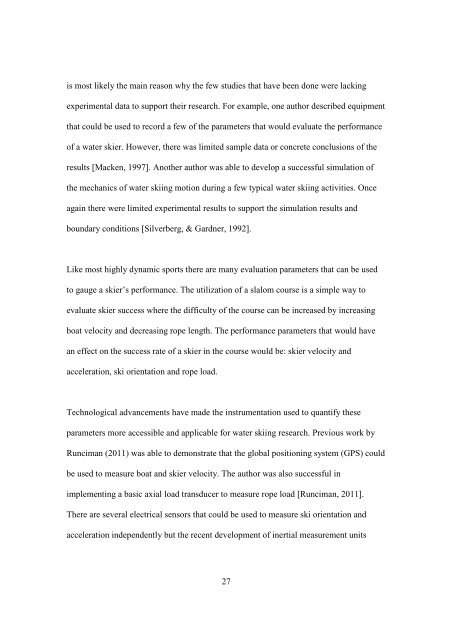Biomechanical P ... Slalom Water Skiing R1.pdf - Atrium - University ...
Biomechanical P ... Slalom Water Skiing R1.pdf - Atrium - University ...
Biomechanical P ... Slalom Water Skiing R1.pdf - Atrium - University ...
- No tags were found...
You also want an ePaper? Increase the reach of your titles
YUMPU automatically turns print PDFs into web optimized ePapers that Google loves.
is most likely the main reason why the few studies that have been done were lackingexperimental data to support their research. For example, one author described equipmentthat could be used to record a few of the parameters that would evaluate the performanceof a water skier. However, there was limited sample data or concrete conclusions of theresults [Macken, 1997]. Another author was able to develop a successful simulation ofthe mechanics of water skiing motion during a few typical water skiing activities. Onceagain there were limited experimental results to support the simulation results andboundary conditions [Silverberg, & Gardner, 1992].Like most highly dynamic sports there are many evaluation parameters that can be usedto gauge a skier’s performance. The utilization of a slalom course is a simple way toevaluate skier success where the difficulty of the course can be increased by increasingboat velocity and decreasing rope length. The performance parameters that would havean effect on the success rate of a skier in the course would be: skier velocity andacceleration, ski orientation and rope load.Technological advancements have made the instrumentation used to quantify theseparameters more accessible and applicable for water skiing research. Previous work byRunciman (2011) was able to demonstrate that the global positioning system (GPS) couldbe used to measure boat and skier velocity. The author was also successful inimplementing a basic axial load transducer to measure rope load [Runciman, 2011].There are several electrical sensors that could be used to measure ski orientation andacceleration independently but the recent development of inertial measurement units27
















